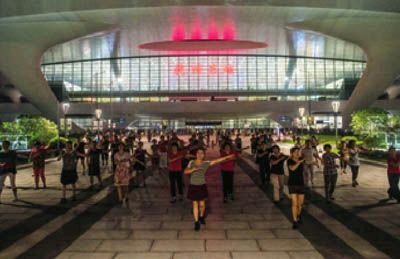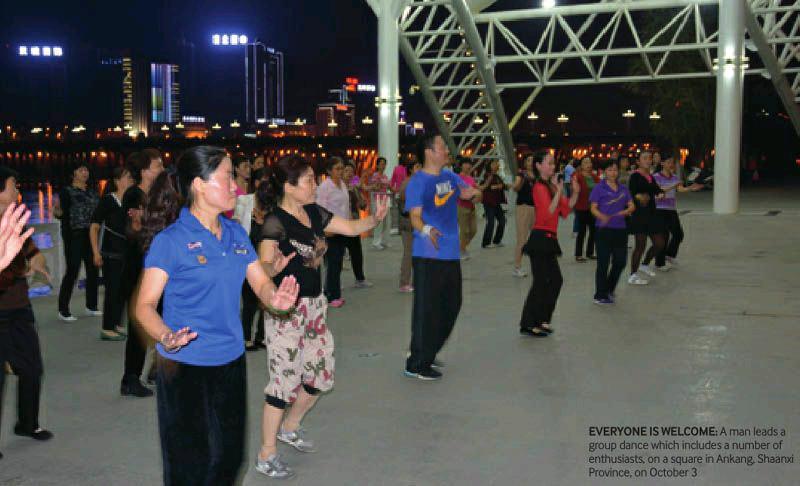Dancing Loud And Proud
2014-12-01ByYuanYuan
By+Yuan+Yuan

Lin Qiaofen has been doing morning exercise in Beijing Purple Bamboo Park for six years since her retirement in 2008. It was not until recently that she learned that this popular form of recreation for seniors is known as square dancing.
She heard the phrase for the first time from her grandson, who learnt it from a series of news reports about how senior Chinese women in Chinese communities overseas dance.
“I was confused when I first heard the name of the dance as we didnt dance in a square, it should be called park dance,” said Lin.
There are about 30 women in Lins dancing group. They gather at 7 a.m. in the park every morning and the organizer, who carries a portable sound system, charges 30 yuan ($4.76) each month. The organizer also gives simple instructions to the new members.
When Lin joined the group six years ago, the music they danced with were mostly old songs from the 1980s or even earlier, though now they even dance to modern pop hits.
Square dancing can be traced back nearly 30 years to public discos in the 1980s. With the introduction of the reform and opening-up policy, dancing in public gained growing acceptance. By the late 1980s, this form of exercise had become a common scene across the parks of all Chinas big cities.
“The movements are simple and easy to learn,” said Lin. “You dont need to spend much time memorizing the dance. Just go along with the music.”
“Square dancing is a good way to get some exercise in the morning and it enriches senior peoples lives,” said Jin Xing, a famous dancer in China. “Groups of people dancing together happily in parks every morning is a sight unique to China. I think other countries could benefit from following our lead.”
In fact, Chinas seniors seem to be eager to spread this small slice of culture. There have been reports of old Chinese women dancing in New Yorks Sunset Park, Moscows Red Square, and in front of Paris Louvre Museum in recent months and in the photographs, the dancers, who dress uniformly, are all dancing with a glowing smile on their faces.
Conflict
Unfortunately, those who have reacted to the dancers have tended not to share their smiles, but rather wear a frown. People living nearby have complained about the noise, and in New York, the square dancers were even confronted by local police to get them to turn the volume down.
Similar conflicts occur in China all the time. When dancers are unable find a park or an open area far from their residence, they choose an open space in their housing community.
“It gives me a headache every time the music starts downstairs at night,” said a resident surnamed Yang in Taizhou, east Chinas Jiangsu Province. “They start dancing around 7 p.m. every day and it lasts for more than an hour. I cant hear myself think.”
Yang said she talked to the dancers but nothing changed and then she had to turn to the local police. “They stopped for a few days but resumed after that,” said Yang.“What can we do?”
Things get worse in summer as Yang has to open the windows. “It sounds they dance right next to my ears,” said Yang.
In November 2013, a man in Beijings suburban Changping District released three Tibetan mastiffs into a crowd of dancing seniors whom he failed to stop after talking with them.
In Wuhan, capital city of central Chinas Hubei Province, a resident put layers of broken glass on the square to stop dancers gathering there. In Wenzhou, east Chinas Zhejiang Province, in order to fight against the noise of square dancing, a group of residents spontaneously raised 260,000 yuan ($42,276) for a“loudspeaker cannon” to cover the dancing noise. This attracted attention from all sectors of society. After coordination, residents eventually agreed to remove the “remote directional sound amplifying system.”
“I think the government should ban square dancing in communities and allocate some specific plots for people to dance,” said a resident surnamed Shi from Shanghai. “It is so annoying, especially in summer.”
Some dancers argue that there is nowhere else for them to go, however. Hu Shuqin, a square dancer from Shanghai, explained that “normally dancers in one group are all neighbors and we need to find a nearby place to gather up, but there are no parks or enough open areas for us to dance. We have no other choice.”
In June, Xian of northwest Chinas Shaanxi Province released draft legislation banning square dances from 10 p.m. to 7 a.m. in residents communities. It says that individuals will be fined 1,000 yuan ($158.73) if they violate the curfew.
Searching for a solution
Scientists from Fudan University have invented an instrument to reduce the noise generated by square dancing, which has been called an“active directional loudspeaker.”
Ma Jianmin, a professor at the Department of Mechanics and Engineering Science in Fudan University explained, “This device enables us to control sound waves within a certain area. Within the area, the sound waves are strong, while out of the area, they will become weaker and eventually fade out. With this instrument, square dances will not disturb residents any more”.
It will take time for the new hi-tech invention to be put into practice, though. Some dancers couldnt wait, however, and have found a solution in bluetooth earplugs.
“One night I was walking in the community and when I turned at a corner I almost screamed—rows of grannies dancing together, but without any sound,” said a netizen from Chongqing Municipality in southwest China.“They were silent and smiling. I swore that I wouldnt walk in the community any more. It creeped me out!”
Another netizen from Beijing praised their innovative solution. “The dancers are smart, and it seems to be the best choice for everyone.”
